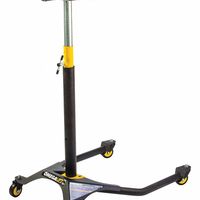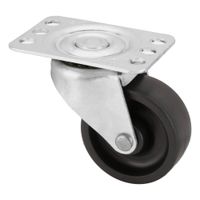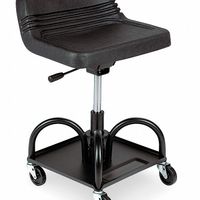Call +(254) 703 030 000 / 751 483 999 / 721 704 777
- Home
- Fleet Vehicle Maintenance
- Garage Equipment
- Creepers Accessories
Creepers & Accessories
Creepers consist of a metal frame, a creeper seat on which the mechanic sits, and a set of casters to move the creeper under vehicles. Creeper accessories include vinyl cushions and headrests for comfort and easy cleaning. Tool trays attach to the sides for keeping repair items within reach. Read Less
Frequently Asked Questions
What is a mechanic's creeper used for?
A mechanic's creeper is a tool used to facilitate the work of automotive technicians and mechanics by allowing them to easily slide under vehicles. It is essentially a low-profile platform on wheels, designed to provide comfort and mobility when accessing the underside of a car or truck. The primary purpose of a mechanic's creeper is to improve efficiency and ergonomics during vehicle maintenance and repair tasks.
Typically, a mechanic's creeper consists of a sturdy frame made from metal or durable plastic, with a padded surface for comfort. It is equipped with swivel casters or wheels that enable smooth movement in any direction, allowing the user to position themselves precisely under the vehicle. Some creepers also feature adjustable headrests or backrests to provide additional support and comfort during prolonged use.
Mechanic's creepers are particularly useful for tasks such as oil changes, exhaust system repairs, transmission work, and inspections of the vehicle's undercarriage. By using a creeper, mechanics can avoid the discomfort and strain associated with lying directly on the ground, reducing the risk of injury and fatigue. This tool also helps maintain a cleaner work environment, as it keeps the user off potentially dirty or oily surfaces.
In addition to traditional creepers, there are also specialized models available, such as folding creepers for easy storage, low-profile creepers for vehicles with limited ground clearance, and even creeper seats that combine the functionality of a creeper with a rolling stool for working at different heights. Overall, a mechanic's creeper is an essential tool for anyone involved in automotive repair, enhancing both the safety and efficiency of their work.
How do you choose the right mechanic's creeper?
To choose the right mechanic's creeper, consider the following factors:
1. **Comfort**: Look for a creeper with adequate padding and ergonomic design to ensure comfort during extended use. Memory foam or thick padding can reduce strain on your back.
2. **Material**: Choose between plastic, metal, or wood frames. Plastic is lightweight and resistant to corrosion, metal is durable but heavier, and wood offers a classic feel but may not be as durable.
3. **Mobility**: Check the quality and size of the wheels. Larger, swivel casters provide better mobility and stability on uneven surfaces. Ensure they are made of durable materials like polyurethane.
4. **Height and Clearance**: Consider the creeper's profile. A low-profile creeper offers better clearance under vehicles, while adjustable models can provide versatility for different tasks.
5. **Weight Capacity**: Ensure the creeper can support your weight comfortably. Most creepers have a weight capacity ranging from 250 to 400 pounds.
6. **Adjustability**: Some creepers offer adjustable headrests or backrests for added comfort and flexibility. This feature can be beneficial for different working positions.
7. **Portability and Storage**: Consider foldable or compact designs for easy storage and transport, especially if space is limited in your garage.
8. **Durability**: Look for creepers with sturdy construction and high-quality materials to ensure longevity. Check for reinforced seams and robust frames.
9. **Price and Warranty**: Balance your budget with the features you need. A warranty can provide peace of mind regarding the product's durability and quality.
10. **Reviews and Recommendations**: Read user reviews and seek recommendations from fellow mechanics to gauge real-world performance and reliability.
By evaluating these factors, you can select a mechanic's creeper that best suits your needs and enhances your efficiency and comfort while working.
What are the benefits of using a mechanic's creeper?
A mechanic's creeper offers several benefits that enhance both the efficiency and comfort of automotive repair tasks:
1. **Ergonomic Comfort**: Creepers are designed to support the body, reducing strain on the back and neck. This ergonomic design helps prevent discomfort and potential injuries during prolonged periods of work under vehicles.
2. **Mobility**: Equipped with swivel casters, creepers allow mechanics to easily glide under vehicles. This mobility facilitates quick repositioning without the need to constantly get up and down, saving time and effort.
3. **Efficiency**: By providing a smooth surface to lie on, creepers enable mechanics to access hard-to-reach areas more easily. This can significantly speed up repair and maintenance tasks, improving overall productivity.
4. **Protection**: Creepers protect clothing from dirt, oil, and other substances commonly found on garage floors. This helps maintain a cleaner work environment and reduces the need for frequent laundering of work clothes.
5. **Durability**: Typically made from robust materials like steel or heavy-duty plastic, creepers are built to withstand the rigors of a workshop environment, ensuring long-term use and reliability.
6. **Adjustability**: Many creepers come with adjustable headrests or back supports, allowing users to customize their position for maximum comfort and optimal access to the vehicle.
7. **Versatility**: Some creepers can be converted into seats or stools, providing additional functionality for tasks that require sitting rather than lying down.
8. **Safety**: By keeping mechanics off the ground, creepers reduce the risk of injury from sharp objects or uneven surfaces on the workshop floor.
Overall, a mechanic's creeper is an essential tool that enhances the working conditions and efficiency of automotive professionals, contributing to better job performance and satisfaction.
How do you maintain a mechanic's creeper?
To maintain a mechanic's creeper, follow these steps:
1. **Regular Cleaning**: After each use, wipe down the creeper with a damp cloth to remove dirt, oil, and grease. For stubborn stains, use a mild detergent and water. Ensure it is completely dry before storing to prevent rust or mold.
2. **Inspect for Damage**: Regularly check the creeper for any signs of wear and tear, such as cracks in the frame, tears in the padding, or loose bolts. Address any issues immediately to prevent further damage or injury.
3. **Lubricate Wheels**: The wheels or casters should be lubricated periodically to ensure smooth movement. Use a suitable lubricant like silicone spray or light machine oil. Check for any debris caught in the wheels and remove it.
4. **Tighten Bolts and Screws**: Over time, bolts and screws can become loose. Regularly inspect and tighten them to maintain the structural integrity of the creeper.
5. **Check Padding**: Ensure the padding is intact and comfortable. If the padding is worn out or damaged, consider replacing it to maintain comfort and support during use.
6. **Storage**: Store the creeper in a dry, clean area to protect it from moisture and dust. If possible, hang it on a wall or keep it off the ground to prevent damage.
7. **Avoid Overloading**: Adhere to the weight limit specified by the manufacturer to prevent structural damage. Overloading can lead to frame bending or wheel failure.
8. **Replace Worn Parts**: If any part of the creeper is beyond repair, replace it promptly. This includes wheels, padding, or any other component that affects functionality.
By following these maintenance steps, you can extend the life of your mechanic's creeper and ensure it remains safe and effective for use.
What features should I look for in a mechanic's creeper?
When selecting a mechanic's creeper, consider the following features:
1. **Comfort**: Look for a creeper with adequate padding or cushioning to ensure comfort during extended use. Memory foam or thick vinyl padding can provide better support.
2. **Durability**: Choose a creeper made from robust materials like steel or heavy-duty plastic to withstand frequent use and support your weight.
3. **Mobility**: Opt for a creeper with high-quality, swivel casters that allow smooth movement in all directions. Larger wheels can handle uneven surfaces better.
4. **Height and Ground Clearance**: Ensure the creeper has a low profile to fit under vehicles with limited clearance. Adjustable height options can offer versatility for different tasks.
5. **Weight Capacity**: Check the maximum weight capacity to ensure it can support your body weight comfortably.
6. **Portability**: Consider a foldable or lightweight design for easy storage and transport. Some models come with handles for added convenience.
7. **Headrest**: An adjustable or padded headrest can enhance comfort, especially during long periods of work.
8. **Length and Width**: Ensure the creeper is long and wide enough to accommodate your body size without restricting movement.
9. **Material**: Look for materials that are easy to clean and resistant to oil, grease, and other automotive fluids.
10. **Additional Features**: Some creepers come with tool trays or magnetic strips to keep tools within reach, enhancing efficiency.
11. **Price and Warranty**: Consider your budget and look for a creeper that offers good value for money. A warranty can provide peace of mind regarding the product's longevity.
By focusing on these features, you can select a mechanic's creeper that meets your needs and enhances your work efficiency.
Are there different types of mechanic's creepers?
Yes, there are different types of mechanic's creepers, each designed to cater to specific needs and preferences. The main types include:
1. **Traditional Creepers**: These are flat platforms with wheels, allowing mechanics to slide under vehicles easily. They often have a padded surface for comfort and a headrest for support.
2. **Low-Profile Creepers**: Designed for vehicles with low ground clearance, these creepers have a thinner frame to allow access to tighter spaces.
3. **Foldable Creepers**: These can be folded into a seat or stool, providing versatility for mechanics who need to alternate between sitting and lying positions.
4. **Adjustable Creepers**: These feature adjustable headrests or backrests, allowing users to customize the angle for better comfort and access.
5. **Pneumatic Creepers**: Equipped with air-filled cushions, these provide enhanced comfort and are ideal for prolonged use.
6. **Creeper Seats**: These are essentially stools on wheels, allowing mechanics to work on parts of the vehicle that are not at ground level. They often come with storage compartments for tools.
7. **Hybrid Creepers**: Combining features of traditional creepers and seats, these can be converted from a flat creeper to a seat, offering flexibility.
8. **Heavy-Duty Creepers**: Built with robust materials, these are designed to support higher weight capacities and withstand rigorous use.
9. **Mechanic's Creeper Mats**: These are simple, padded mats without wheels, offering a lightweight and portable option for quick jobs.
Each type of creeper is designed to enhance the mechanic's comfort and efficiency, catering to different working environments and personal preferences.
How much weight can a mechanic's creeper support?
A mechanic's creeper can typically support a weight range between 250 to 400 pounds (approximately 113 to 181 kilograms). However, the exact weight capacity can vary depending on the design, materials, and manufacturer specifications. Some heavy-duty models are designed to support even more weight, sometimes up to 500 pounds (about 227 kilograms) or more. It's important to check the specific product details for the weight capacity to ensure safety and proper use.


